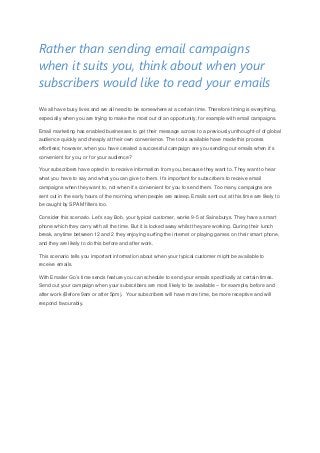
Rather Than Sending Email Campaigns When It Suits You, Send Them..
- 1. Rather than sending email campaigns when it suits you, think about when your subscribers would like to read your emails We all have busy lives and we all need to be somewhere at a certain time. Therefore timing is everything, especially when you are trying to make the most out of an opportunity, for example with email campaigns. Email marketing has enabled businesses to get their message across to a previously unthought-of of global audience quickly and cheaply at their own convenience. The tools available have made this process effortless; however, when you have created a successful campaign are you sending out emails when it’s convenient for you, or for your audience? Your subscribers have opted in to receive information from you, because they want to. They want to hear what you have to say and what you can give to them. It’s important for subscribers to receive email campaigns when they want to, not when it’s convenient for you to send them. Too many campaigns are sent out in the early hours of the morning, when people are asleep. Emails sent out at this time are likely to be caught by SPAM filters too. Consider this scenario. Let’s say Bob, your typical customer, works 9-5 at Sainsburys. They have a smart phone which they carry with all the time. But it is locked away whilst they are working. During their lunch break, anytime between 12 and 2 they enjoying surfing the internet or playing games on their smart phone, and they are likely to do this before and after work. This scenario tells you important information about when your typical customer might be available to receive emails. With Emailer Go’s time sends feature you can schedule to send your emails specifically at certain times. Send out your campaign when your subscribers are most likely to be available – for example, before and after work (Before 9am or after 5pm). Your subscribers will have more time, be more receptive and will respond favourably.
